Territorial Inequalities, Ecological and Material Footprints of the Energy Transition: Case Study of the Cantabrian-Mediterranean Bioregion
Abstract
:1. Introduction
2. Methodology
2.1. Renewable Energy Self-Sufficiency
2.2. Ecological Footprint
2.3. Global Equivalent Mineral Footprint
3. The case of the Cantabrian-Mediterranean Bioregion
3.1. Description of the Bioregion
3.2. Energy Transition Scenarios for the Bioregion
- The 2030 scenario is based on the National Integrated Energy and Climate Plan (PNIEC) [21], which proposes to produce 74% of electricity with renewable generation and a 4% increase in electricity demand. This should be achieved by replacing conventional boilers with heat pumps and by electrifying combustion vehicles. With additional energy efficiency measures, a reduction of 15% in the final energy consumption is expected. Furthermore, PNIEC plans to install 57 GW of renewable nameplate capacity and deinstall 16 GW nameplate capacity of conventional power plants in Spain.
- The 2050 scenario is a zero-emission economy, based on replacing fossil energy sources with RES, mainly through electrification, in a 100% renewable electricity system.
- The 2050 efficient scenario considers a reduction in energy and material demands but maintains the predictions of increased activity thanks to greater use of public transport, shared mobility [39], shared road freight transport [40], and train transportation instead of road freight transportation [41]. In addition, greater energy efficiency in buildings due to isolation is considered (20% energy demand reduction for heating).
- The trend scenario considers the current new renewable nameplate capacity installation trend by territory.
- The balanced scenario is an alternative option in which the renewable nameplate capacity installation by autonomous communities is estimated according to their domestic energy needs. When an autonomous community does not have enough renewable resources, the neighboring autonomous communities provide the necessary renewable resources. The installed nameplate capacity is equivalent to the trend scenario but differs in the distribution among autonomous communities.
3.3. Model Assumptions
3.4. Data Gathering
4. Results
4.1. Renewable Energy Self-Sufficiency
- Renewable energies require large surface areas. Even if they are polygonal areas, the territory is conditioned over an extended period of at least 30 to 100 years. Its installation must seek compatibility with traditional land uses and the maintenance of vital ecosystem services [88].
- An emerging imbalance between electricity production and consumption in autonomous communities could lead to increased inequalities. The least populated autonomous communities would generate energy for the most populated ones, allowing its higher development and attracting more population.
- To avoid renewable installation bubbles. By June 2022, the PNIEC targets for 2030 were doubled, adding together the power in service and the power with access permits [89].
4.2. Ecological Footprint—Territory Equivalent
4.3. Global Equivalent Mineral Footprint
5. Conclusions
Supplementary Materials
Author Contributions
Funding
Data Availability Statement
Acknowledgments
Conflicts of Interest
References
- United Nations. Paris Agreement. In Proceedings of the 21st Conference Parties, Paris, France, 11 December 2015. [Google Scholar]
- EU Commission. Long-Term Strategy for 2050. 2022. Available online: https://ec.europa.eu/clima/eu-action/climate-strategies-targets/2050-long-term-strategy_es (accessed on 15 June 2022).
- IEA. Net Zero by 2050, A Roadmap for the Global Energy Sector; International Energy Agency: Paris, France, 2021. [Google Scholar]
- EC Comission. Glosary: Carbon Dioxide Equivalent. 2022. Available online: https://ec.europa.eu/eurostat/statistics-explained/index.php?title=Glossary:Carbon_dioxide_equivalent#:~:text=A%20carbon%20dioxide%20equivalent%20or,with%20the%20same%20global%20warming (accessed on 15 September 2022).
- Jacobson, M.Z.; Delucchi, M.A.; Cameron, M.A.; Manogaran, I.P.; Shu, Y.; von Krauland, A.-K. Impacts of Green New Deal Energy Plans on Grid Stability, Costs, Jobs, Health, and Climate in 143 countries. One Earth 2019, 1, 449–463. [Google Scholar] [CrossRef]
- Child, M.; Bogdanov, D.; Breyer, C. The role of storage technologies for the transition to a 100% renewable energy system in Europe. Energy Procedia 2018, 155, 44–60. [Google Scholar] [CrossRef]
- MITECO. Estrategia de Descarbonización a Largo Plazo 2050. In Estrategia a Largo Plazo Para una Economía Española, Moderna, Competitiva y Climáticamente Neutra a 2050; Ministerio para la Transición Ecológica y el Reto Demográfico: Madrid, Spain, 2020; Available online: https://www.miteco.gob.es/es/prensa/ultimas-noticias/el-gobierno-aprueba-la-estrategia-de-descarbonizaci%C3%B3n-a-largo-plazo-que-marca-la-senda-para-alcanzar-la-neutralidad-clim%C3%A1tica-a-2050/tcm:30-516141 (accessed on 29 July 2022).
- Hussain, A.; Perwez, U.; Ullah, K.; Kim, C.; Asghar, N. Long-term scenario pathways to assess the potential of best available technologies and cost reduction of avoided carbon emissions in an existing 100% renewable regional power system: A case study of Gilgit-Baltistan (GB), Pakistan. Energy 2021, 221, 119855. [Google Scholar] [CrossRef]
- Felipe Andreu, J.; Schneider, D.; Krajačić, G. Evaluation of integration of solar energy into the district heating system of the city of Velika Gorica. Ther. Sci. 2016, 20, 1049–1060. [Google Scholar] [CrossRef] [Green Version]
- Poggi, F.; Firmino, A.; Amado, M. Planning renewable energy in rural areas: Impacts on occupation and land use. Energy 2018, 155, 630–640. [Google Scholar] [CrossRef]
- De Pascali, P.; Bagaini, A. Energy Transition and Urban Planning for Local Development. A Critical Review of the Evolution of Integrated Spatial and Energy Planning. Energies 2019, 12, 35. [Google Scholar] [CrossRef] [Green Version]
- Valero, A.; Valero, A.; Calvo, G.; Ortego, A. Material bottlenecks in the future development of green technologies. Renew. Sustain. Energy Rev. 2018, 93, 178–200. [Google Scholar] [CrossRef]
- IEA. The Role of Critical Minerals in Clean Energy Transitions, World Energy Outlook Special Report; International Energy Agency: Paris, France, 2021. [Google Scholar]
- Calvo, G.; Valero, A. Strategic mineral resources: Availability and future estimations for the renewable energy sector. Environ. Dev. 2022, 41, 100640. [Google Scholar] [CrossRef]
- Calvo, G.; Valero, A.; Valero, A. Thermodynamic Approach to Evaluate the Criticality of Raw Materials and Its Application through a Material Flow Analysis in Europe. J. Ind. Ecol. 2017, 22, 839–852. [Google Scholar] [CrossRef] [Green Version]
- Calvo, G.; Valero, A.; Valero, A. Assessing maximum production peak and resource availability of non-fuel mineral resources: Analyzing the influence of extractable global resources. Res. Conserv. Recycl. 2017, 125, 208–217. [Google Scholar] [CrossRef]
- Ortego, A.; Calvo, G.; Valero, A.; Iglesias-Émbil, M.; Valero, A.; Villacampa, M. Assessment of strategic raw materials in the automobile sector. Res. Conserv. Recycl. 2020, 161, 104968. [Google Scholar] [CrossRef]
- EU Commission. Critical Raw Material List. 2022. Available online: https://rmis.jrc.ec.europa.eu/?page=crm-list-2020-e294f6. (accessed on 10 July 2022).
- Partington, R. Inflation in Eurozone Hits Record 8.6% as Ukraine War Continues. The Guardian. 1 July 2022. Available online: https://www.theguardian.com/business/2022/jul/01/inflation-in-eurozone-hits-record-86-as-ukraine-war-continues (accessed on 6 September 2022).
- Caldara, D.; Conlisk, S.; Iacoviello, M.; Penn, M. The Effect of the War in Ukraine on Global Activity and Inflation; FEDS Notes; Board of Governors of the Federal Reserve System: Washington, DC, USA, 27 May 2022. [Google Scholar] [CrossRef]
- IDAE; MITECO. Plan Nacional Integrado de Energía y Clima; Ministerio Para la Transición Ecológica y el Reto Demográfico: Madrid, Spain, 2020. [Google Scholar]
- Zalk, J.; Behrens, P. The spatial extent of renewable and non-renewable power generation: A review and meta-analysis of power densities and their application in the U.S. Energy Policy 2018, 123, 83–91. [Google Scholar] [CrossRef]
- Global Footprint Network. Ecological Footprint. 2021. Available online: https://www.footprintnetwork.org/our-work/ecological-footprint/ (accessed on 1 October 2021).
- Global Footprint Network. Glossary. 2022. Available online: https://www.footprintnetwork.org/resources/glossary/ (accessed on 5 June 2022).
- Valero, A.; Valero, A. Thanatia, The Destiny of the Earth’s Mineral Resources: A Cradle-to-Cradle Assessment; World Sci. Publ. Co.: Hackensack, NJ, USA, 2014; ISBN 978-981-4273-93-0. [Google Scholar]
- Schmidt-Bleek, F. MIPS—A universal ecological measure? Fresenius Environ. Bull. 1993, 2, 306–311. [Google Scholar]
- UNDP. Planetary Pressures—Adjusted Human Development Index (PHDI). 2022. Available online: https://hdr.undp.org/planetary-pressures-adjusted-human-development-index#/indicies/PHDI (accessed on 30 July 2022).
- Valero, A.; Valero, A.; Calvo, G. The Material Limits of Energy Transition: Thanatia; Springer Nature: Cham, Switzerland, 2021; ISBN 978-3-03078532-1. [Google Scholar]
- Palacios, J.-L.; Calvo, G.; Valero, A.; Valero, A. The cost of mineral depletion in Latin America: An exergoecology view. Resour. Policy 2018, 59, 117–124. [Google Scholar] [CrossRef]
- Palacios, J.-L.; Calvo, G.; Valero, A.; Valero, A. Exergoecology Assessment of Mineral Exports from Latin America: Beyond a Tonnage Perspective. Sustainability 2018, 10, 723. [Google Scholar] [CrossRef] [Green Version]
- Valero, A.; Valero, A.; Arauzo, I. Evolution of the decrease in mineral exergy throughout the 20th century. The case of copper in the US. Energy 2008, 33, 107–115. [Google Scholar] [CrossRef]
- Valero, A.; Valero, A. Es la Entropía, Estúpido! In Bioeconomía Para el Siglo XXI. Actualidad de Nicholas Georgescu-Roegen; Arenas, L., Naredo, J.M., Riechmann, J., Eds.; Libros de la Catarata Publ.: Madrid, Spain, 2022; pp. 185–227. ISBN 978-84-1352-500-6. [Google Scholar]
- United States Geological Survey USGS. USGS Online Publications Directory. 2022. Available online: https://pubs.usgs.gov/periodicals/mcs2022/ (accessed on 25 February 2022).
- Grupo Aragonés del Capítulo Español del Club de Roma. Reunión 22 de Septiembre Biorregión Cantábrico-Mediterránea (Meeting September 22 Cantabrian-Mediterranean Bioregion). 2021. Available online: https://www.clubderoma-aragon.org/eventos/reunion-22-de-septiembre-biorregion-cantabrico-mediterranea/ (accessed on 6 July 2021).
- Fundación Foros de la Concordia. La Biorregión Cantábrico-Mediterránea (BCM) Constituye un Espacio Geográfico con Raíces Naturales, Sociales e Históricas Comunes, Que Encuentra en el Río EBRO su Gran Eje Vertebrador (The Cantabrian-Mediterranean bioregion (BCM) Constitutes a Geographical Space with Common Natural, Social and Historical Roots, which Finds Its Great Backbone in the Ebro River). 2021. Available online: https://www.bioebro.org/la-biorregion/ (accessed on 25 August 2021).
- Expansión/Datosmacro.com. El PIB de las Comunidades Autónomas (The GDP of the Autonomous Communities). 2021. Available online: https://datosmacro.expansion.com/pib/espana-comunidades-autonomas (accessed on 6 July 2021).
- The World Bank. Consumo de Energía Procedente de Combustibles Fósiles (Energy Consumption from Fossil Fuels). 2022. Available online: https://datos.bancomundial.org/indicator/EG.USE.COMM.FO.ZS (accessed on 20 June 2022).
- REE; MITECO. Plan de Desarrollo de la Red de Transporte de Energía Eléctrica Período 2021–2026; Red Eléctrica de España: Madrid, Spain, 2021. [Google Scholar]
- Bistaffa, F.; Blum, C.; Cerquides, J.; Farinelli, A.; Rodríguez-Aguilar, J. A Computational Approach to Quantify the Benefits of Ridesharing for Policy Makers and Travellers. IEEE Trans. Intell. Transp. Syst. 2021, 22, 119–130. [Google Scholar] [CrossRef]
- Jonge, D.D.; Bistaffa, F.; Levy, J. A Heuristic Algorithm for Multi-Agent Vehicle Routing with Automated Negotiation. In Proceedings of the 20th International Conference on Autonomous Agents and Multiagent Systems (AAMAS), Virtual Event. London, UK, 3–7 May 2021; pp. 404–412. Available online: http://hdl.handle.net/10261/257887 (accessed on 6 August 2022).
- García-Álvarez, A.; Pérez-Martínez, P.J.; González-Franco, I. Energy Consumption and Carbon Dioxide Emissions in Rail and Road Freight Transport in Spain: A Case Study of Car Carriers and Bulk Petrochemicals. J. Intell. Transp. Syst. 2013, 17, 233–244. [Google Scholar] [CrossRef] [Green Version]
- IDAE. Análisis del Recurso. Atlas Eólico de España. Estudio Técnico PER 2011–2020; Ministerio Para la Transición Ecológica y el Reto Demográfico: Madrid, Spain, 2011. [Google Scholar]
- Enevoldsen, P.; Jacobson, M. Data investigation of installed and output power densities of onshore and offshore wind turbines worldwide. Energy Sustain. Dev. 2021, 60, 40–51. [Google Scholar] [CrossRef]
- Álvarez, C.; Zafra, M. Cuánto Ocupan las Megacentrales Solares: Investigadores Alertan del Impacto del ‘Boom’ Fotovoltaico. El País. 23 January 2021. Available online: https://elpais.com/clima-y-medio-ambiente/2021-01-23/cuanto-ocupan-las-megacentrales-solares-investigadores-alertan-del-impacto-del-boom-fotovoltaico.html (accessed on 5 August 2021).
- EC. EU Reference Scenario 2020, Energy, Transport and GHG Emissions—Trends 2050; European Commission: Brussels, Belgium, 2021. [Google Scholar]
- Paula-Elena, D.; Liviu-George, M. The relationship between Income, Consumption and GDP: A Time Series, Cross-Country Analysis. Procedia Econ. Financ. 2015, 23, 1535–1543. [Google Scholar] [CrossRef]
- Nguyen, T.-V.; Schnidrig, J.; Maréchal, F. An Analysis of the Impacts of Green Mobility Strategies and Technologies on Different European Energy Systems. In Proceedings of the ECOS 2021—The 34th International Conference on Efficiency, Cost, Optimization, Simulation and Environmental Impact of Energy Systems, Sicily, Italy, 28 June 2021. [Google Scholar]
- Schnidrig, J.; Nguyen, T.-V.; Li, X.; Maréchal, F. A Modelling Framework for Assessing the Impact of Green Mobility Technologies on Energy Systems. In Proceedings of the ECOS 2021—The 34th International Conference on Efficiency, Cost, Optimization, Simulation and Environmental Impact of Energy Systems, Sicily, Italy, 28 June 2021. [Google Scholar]
- García Álvarez, A.; Martín Cañizares, M.D.P. Metodología de Cálculo del Consumo de Energía de Los Trenes de Viajeros y Actuaciones en el Diseño del Material Rodante Para su Reducción; ElecRail: Madrid, Spain, 2010. [Google Scholar]
- EU Commission. EU Reference Scenario 2020. 2021. Available online: https://ec.europa.eu/energy/data-analysis/energy-modelling/eu-reference-scenario-2020_en (accessed on 27 July 2021).
- Hager, T.J.; Morawicki, R. Energy consumption during cooking in the residential sector of developed nations: A review. Food Policy 2013, 40, 54–63. [Google Scholar] [CrossRef]
- Economics for Energy. Escenarios Para el Sector Energético en España 2030–2050; Economics for Energy: Vigo, Spain, 2017. [Google Scholar]
- MITECO. Estrategia a Largo Plazo Para Una Economía Española Moderna, Competitiva y Climáticamente Neutra en 2050; Anexos; Ministerio Para la Transición Ecológica y el Reto Demográfico: Madrid, Spain, 2020; Available online: https://ec.europa.eu/clima/sites/lts/lts_es_es.pdf (accessed on 29 July 2022).
- Magdalena, R.; Calvo, G.; Valero, A. The Energy Cost of Extracting Critical Raw Materials from Tailings: The Case of Coltan. Geosciences 2022, 12, 214. [Google Scholar] [CrossRef]
- Gobierno de Aragón. Boletín de Coyuntura Energética en Aragón 2018; Gobierno de Aragón: Zaragoza, Spain, 2019. [Google Scholar]
- Govern Illes Balears. Portal Energètic (Energy Portal). 2021. Available online: http://www.caib.es/sites/energia/ca/publicacions_estadistiques_i_preus_de_lenergia-7491/ (accessed on 6 July 2021).
- Instituto Catalán de Energía. Balance Energético de Cataluña (Catalonian Energy Balance). 2021. Available online: http://icaen.gencat.cat/es/energia/estadistiques/resultats/anuals/balanc_energetic/ (accessed on 6 July 2021).
- Ivace Energía. Datos Energéticos de la Comunitat Valenciana; Generalitat Valenciana: Valencia, Spain, 2019. [Google Scholar]
- Área de Estudios y Planificación. Euskadi Energía 2018, Datos Energéticos; Ente Vasco de la Energía: Bilbao, Spain, 2020. [Google Scholar]
- Eustat. Datos Energéticos de la C.A. de Euskadi (Energy Data of Basque Country Autonomous Community). 2021. Available online: https://www.eustat.eus/estadisticas/tema_552/opt_1/tipo_1/ti_datos-energeticos-de-la-c-a/temas.html#el (accessed on 6 July 2021).
- Gobierno de Navarra. Balance Energético de Navarra; Gobierno de Navarra: Pamplona, Spain, 2018. [Google Scholar]
- MITECO. La energía en España 2018; Ministerio Para la Transición Ecológica y el Reto Demográfico: Madrid, Spain, 2020. [Google Scholar]
- IDAE. Informe Sintético de Indicadores de Eficiencia Energética en España. Año 2018; Ministerio para la transición ecológica y el reto demográfico: Madrid, Spain, 2020. [Google Scholar]
- IDAE; MITECO. Consumo de Energía Final (Final Energy Consumption). 2021. Available online: http://sieeweb.idae.es/consumofinal/ (accessed on 6 July 2021).
- REE. El Sistema Eléctrico Español 2018; Red Eléctrica de España: Madrid, Spain, 2019. [Google Scholar]
- REE. El Sistema Eléctrico Español Informe 2020, Producción de Energía Eléctrica; Red Eléctrica de España: Madrid, Spain, 2021. [Google Scholar]
- Ministerio de Transportes, Movilidad y Agenda Urbana. Consumo Energético en el Transporte por Modo, Tipo de Combustible y Tipo de Tráfico (Energy Consumption in Transport by Mode, Type of Fuel and Type of Traffic). 2021. Available online: https://apps.fomento.gob.es/BDOTLE/visorBDpop.aspx?i=314 (accessed on 14 July 2021).
- Dirección General de Tráfico. Series Históricas del Parque de Vehículos. 2021. Available online: https://www.dgt.es/es/seguridad-vial/estadisticas-e-indicadores/parque-vehiculos/series-historicas/ (accessed on 15 July 2021).
- DGT. Análisis Sobre los Kilómetros Anotados en las ITV; Dirección General de Tráfico: Madrid, Spain, 2018. [Google Scholar]
- IDAE; MITECO. Informe Anual del Consumo Energético Año 2019; Ministerio para la transición ecológica y el reto demográfico: Madrid, Spain, 2020. [Google Scholar]
- Economics for Energy. Estrategias Para la Descarbonización del Transporte Terrestre en España, Un Análisis de Escenarios; Economics for Energy: Vigo, Spain, 2020. [Google Scholar]
- INE. Proyecciones de Población 2020–2070; Instituto Nacional de Estadística: Madrid, Spain, 2020. [Google Scholar]
- JRC. Photovoltaic Geographical Information System. 2021. Available online: https://re.jrc.ec.europa.eu/pvg_tools/en/ (accessed on 20 July 2021).
- IDAE. Situación y Potencial de Generación de Biogás; Ministerio Para la Transición Ecológica y el Reto Demográfico: Madrid, Spain, 2011. [Google Scholar]
- IDAE. Evaluación del Potencial de Energía de la Biomasa, Estudio Técnico PER 2011–2020; Ministerio Para la Transición Ecológica y el Reto Demográfico: Madrid, Spain, 2011. [Google Scholar]
- Observatorio Sostenibilidad. 1 millón de Tejados Solares en 2025: Energía Rentable y Accesible Para los Ciudadanos; Observatorio Sostenibilidad: Madrid, Spain, 2021. [Google Scholar]
- Bódis, K.; Kougias, I.; Jäger-Waldau, A.; Taylor, N.; Szabó, S. A high-resolution geospatial assessment of the rooftop solar photovoltaic potential in the European Union. Renew. Sustain. Energy Rev. 2019, 114, 109309. [Google Scholar] [CrossRef]
- Azam, A.; Rafiq, M.; Shafique, M.; Zhang, H.; Yuan, J. Analyzing the effect of natural gas, nuclear energy and renewable energy on GDP and carbon emissions: A multi-variate panel data analysis. Energy 2021, 219, 119592. [Google Scholar] [CrossRef]
- KumarNarayan, P.; Narayan, S.; Popp, S. A note on the long-run elasticities from the energy consumption—GDP relationship. Appl. Energy 2010, 87, 1054–1057. [Google Scholar] [CrossRef]
- Iglesias-Émbil, M.; Valero, A.; Ortego, A.; Villacampa, M.; Vilaró, J.; Villalba, G. Raw material use in a battery electric car—A thermodynamic rarity assessment. Resour. Conserv. Recycl. 2020, 158, 104820. [Google Scholar] [CrossRef]
- Carrara, S.; Dias, P.A.; Plazzotta, B.; Pavel, C. Raw Materials Demand for Wind and Solar PV Technologies in the Transition Towards a Decarbonized Energy System; EUR 30095 EN; Publications Office of the European Union: Luxembourg, 2020; Available online: https://data.europa.eu/doi/10.2760/160859 (accessed on 5 September 2021)ISBN 978-92-76-16225-4. [CrossRef]
- Ashby, M.; Attwood, J.; Lord, F. Materials for Low-Carbon Power—A White Paper, 2nd ed.; Granta Teaching Resources; Granta Design: Cambridge, UK, 2012. [Google Scholar]
- García-Olivares, A.; Ballabrera-Poy, J.; García-Ladona, E.; Turiel, A. A global renewable mix with proven technologies and common materials. Energy Policy 2012, 41, 561–574. [Google Scholar] [CrossRef] [Green Version]
- Jones, H.; Moura, F.; Domingos, T. Life cycle assessment of high-speed rail: A case study in Portugal. Int. J. Life Cycle Assess. 2017, 22, 410–422. [Google Scholar] [CrossRef]
- Verdejo, E.Z. Requerimientos Materiales de la Transmisión y Distribución de la Electricidad Para la Transición Energética. Master’s Thesis, Universidad de Valladolid, Escuela de Ingenierías Industriales, Valladolid, Spain, 2021. [Google Scholar]
- ALIENTE. Manifestaciones ALIENTE (ALIENTE Protests). 2022. Available online: https://aliente.org/category/campanas/manifestaciones-aliente (accessed on 30 June 2022).
- Hernández, A. Renovable sí, Pero no así. La razón. 11 October 2021. Available online: https://www.larazon.es/opinion/20211012/jeiekwh5xfbjxcut4lc7ltglsi.html (accessed on 1 May 2022).
- Pérez, B.P.; Díaz-Cuevas, P. Connections between Water, Energy and Landscape: The Social Acceptance in the Monachil River Valley (South of Spain). Land 2022, 11, 1203. [Google Scholar] [CrossRef]
- REE. Estado del Acceso y Conexión de la Generación Renovable Eólica y Solar Fotovoltaica. 2022. Available online: https://www.ree.es/es/clientes/datos-acumulados-generacion-renovable (accessed on 25 June 2022).
- Temper, L.; del Bene, D.; Martinez-Alier, J. Mapping the frontiers and front lines of global environmental justice: The EJAtlas. J. Polit. Ecol. 2015, 22, 255–278. [Google Scholar] [CrossRef] [Green Version]
- Mavhunga, C.C.; Trischler, H. Energy (and) Colonialism, Energy (In)Dependence: Africa, Europe, Greenland, North America. RCC Perspect. 2014, 5, 264–266. [Google Scholar] [CrossRef]
- Valero, A.; Torrubia, J. Libro Blanco de la Biorregión Cantábrico-Mediterránea. Cap 4. Fundación Foros de la Concordia y Capitulo Español del Club de Roma; Fundación Foros de la Concordia: Alcañiz, Spain, 2020. [Google Scholar]
- Bruckner, T.; Bashmakov, I.; Mulugetta, Y.; Chum, H.; Navarro, A.D.L.V.; Edmonds, J.; Faaij, A.; Fungtammasan, B.; Garg, A.; Hertwich, E.; et al. Climate Change 2014: Mitigation of Climate Change. Contribution of Working Group III to the Fifth Assessment Report of the Intergovernmental Panel on Climate Change; Cambridge University Press: Cambridge, UK; New York, NY, USA, 2014. [Google Scholar]
- Ambrose, H.; Kendall, A.; Lozano, M.; Wachche, S.; Fulton, L. Trends in life cycle greenhouse gas emissions of future light duty electric vehicles. Transp. Res. Part D Transp. Environ. 2020, 18, 102287. [Google Scholar] [CrossRef] [Green Version]
- Lee, D.; Thomas, V.M.; Brown, M.A. Electric Urban Delivery Trucks: Energy Use, Greenhouse Gas Emissions, and Cost-Effectiveness. Environ. Sci. Technol. 2013, 47, 8022–8030. [Google Scholar] [CrossRef] [PubMed]
- Carranza, G.; Nascimiento, M.D.; Fanals, J.; Febrer, J.; Valderrama, C. Life cycle assessment and economic analysis of the electric motorcycle in the city of Barcelona and the impact on air pollution. Sci. Total Environ. 2022, 821, 153419. [Google Scholar] [CrossRef]
- Ministerio de Consumo/EC-JRC. Sostenibilidad del Consumo en España. Evaluación del Impacto Ambiental Asociado a los Patrones de Consumo Mediante Análisis del Ciclo de Vida; Ministerio de Consumo: Madrid, Spain, 2022. [Google Scholar]
- UN. Una Población en Crecimiento. 2022. Available online: https://www.un.org/es/global-issues/population (accessed on 2 February 2022).
- Carnegie Europe; Open Society European Policy Institute. The EU and Climate Security: Toward Ecological Diplomacy; Carnegie Endowment for International Peace: Washington, DC, USA, 2021. [Google Scholar]
- Lallana, M.; Almazán, A.; Valero, A.; Lareo, Á. Assessing Energy Descent Scenarios for the Ecological Transition in Spain 2020–2030. Sustainability 2021, 13, 11867. [Google Scholar] [CrossRef]
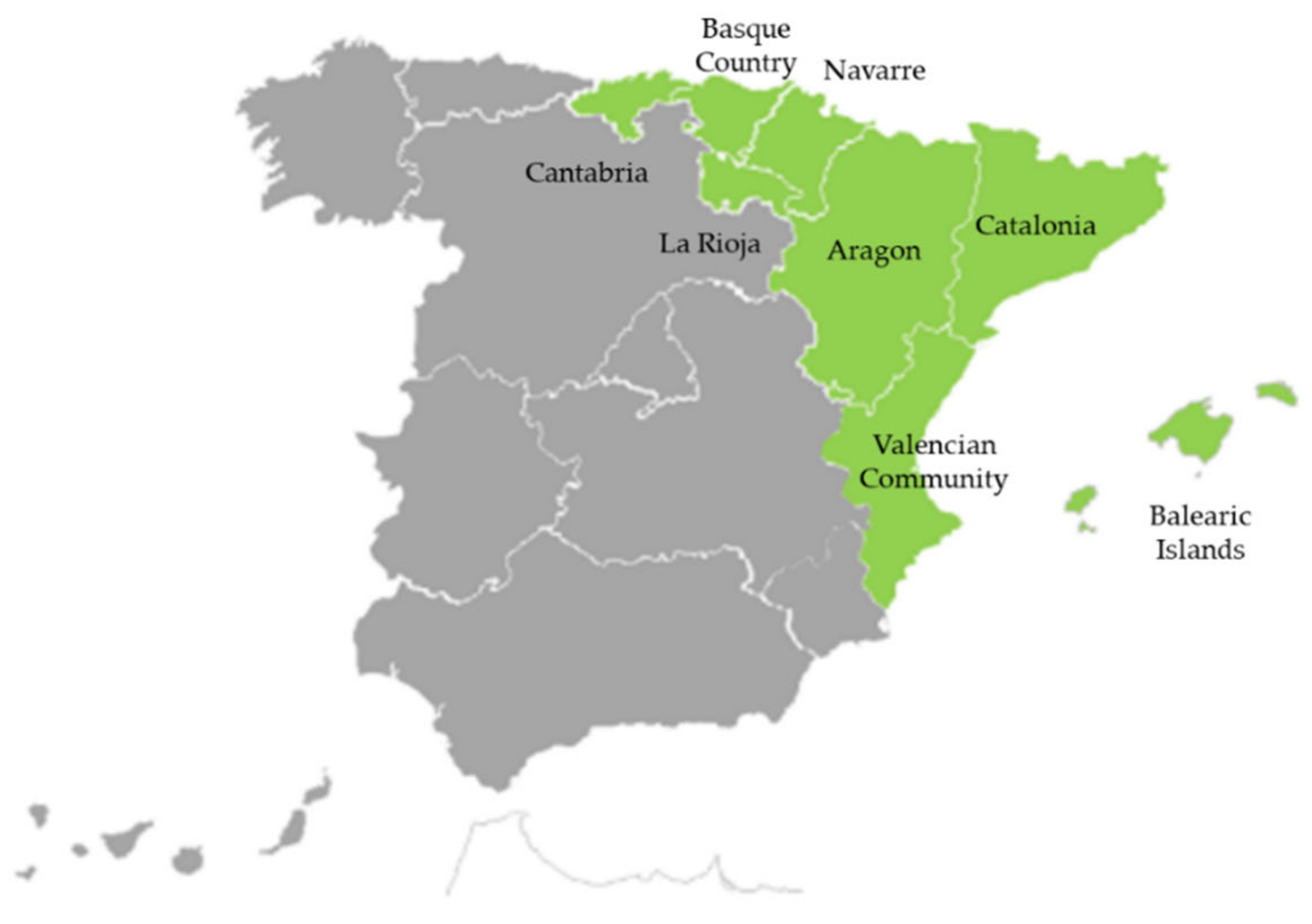
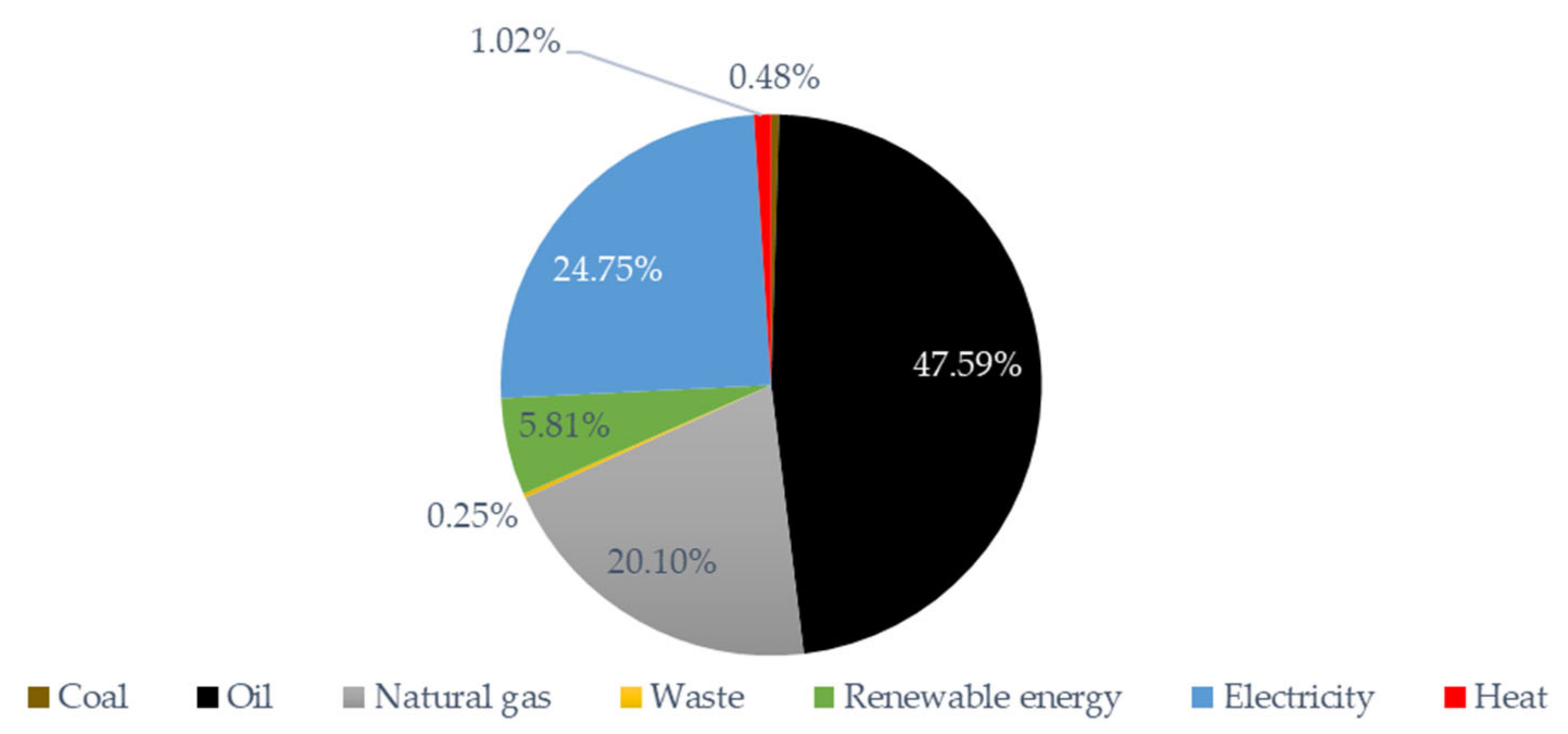
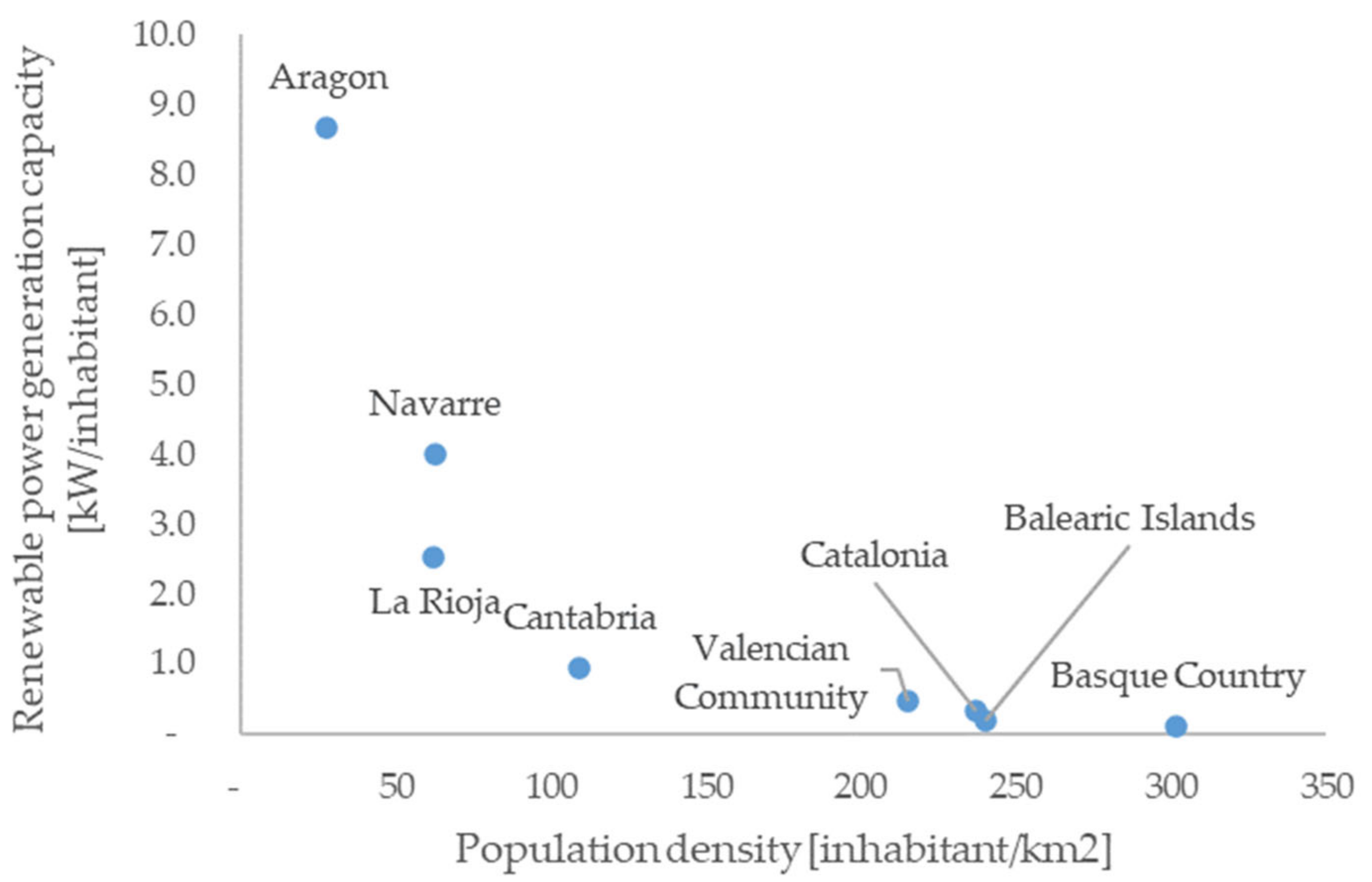

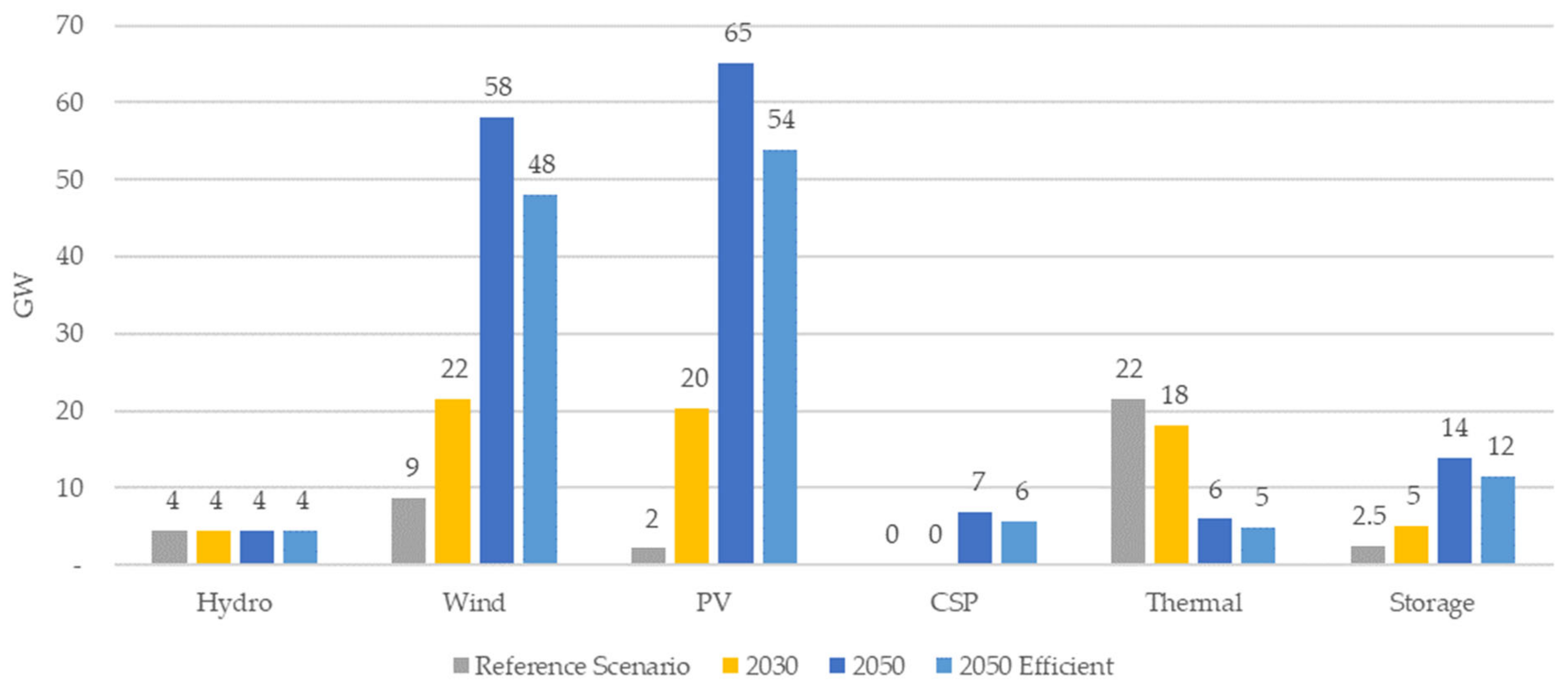

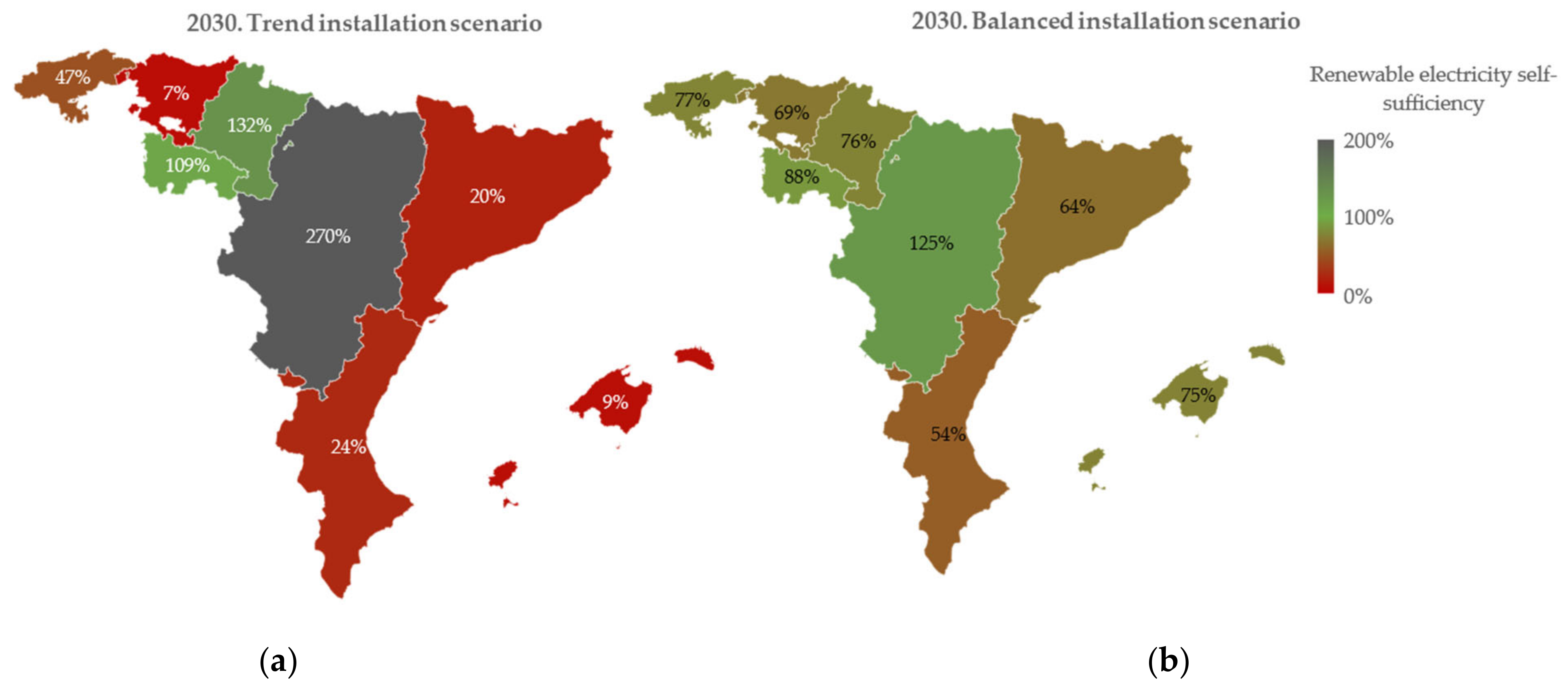
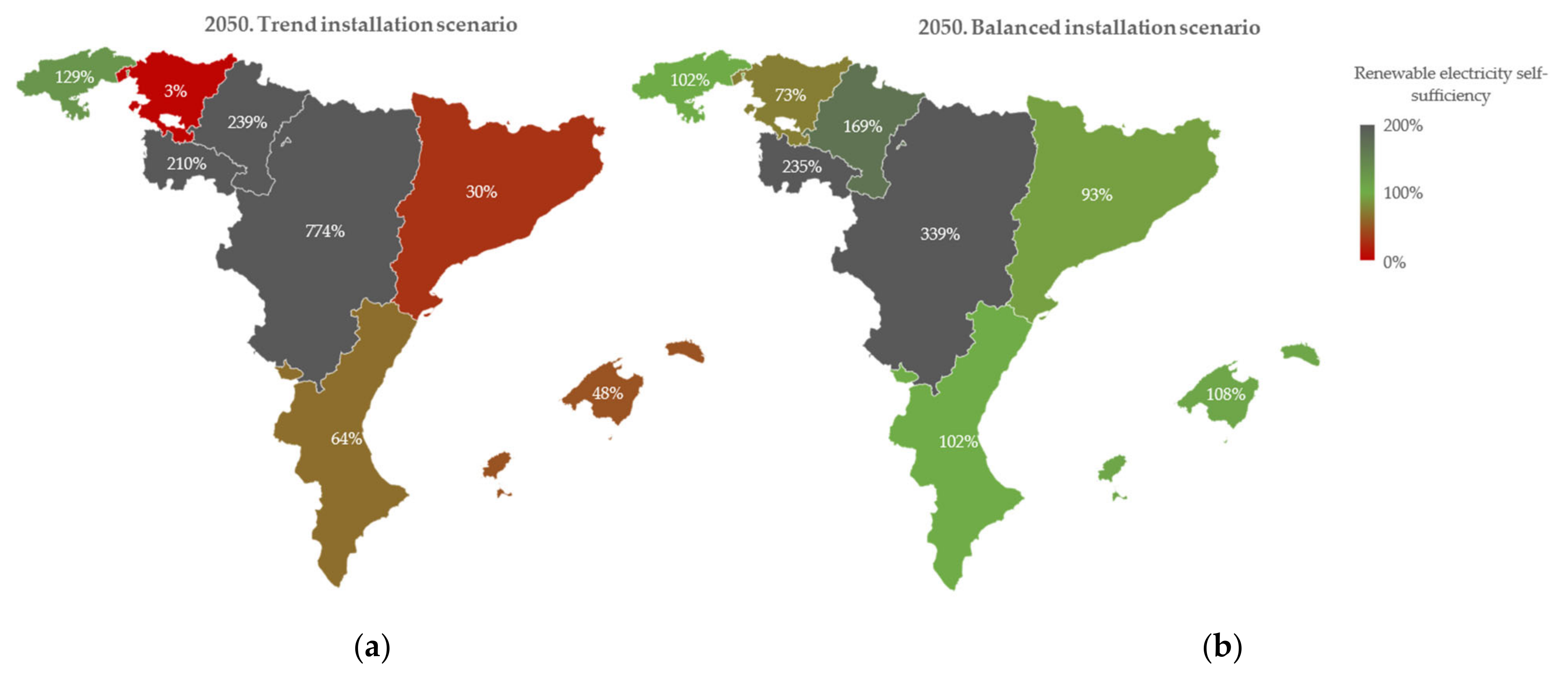

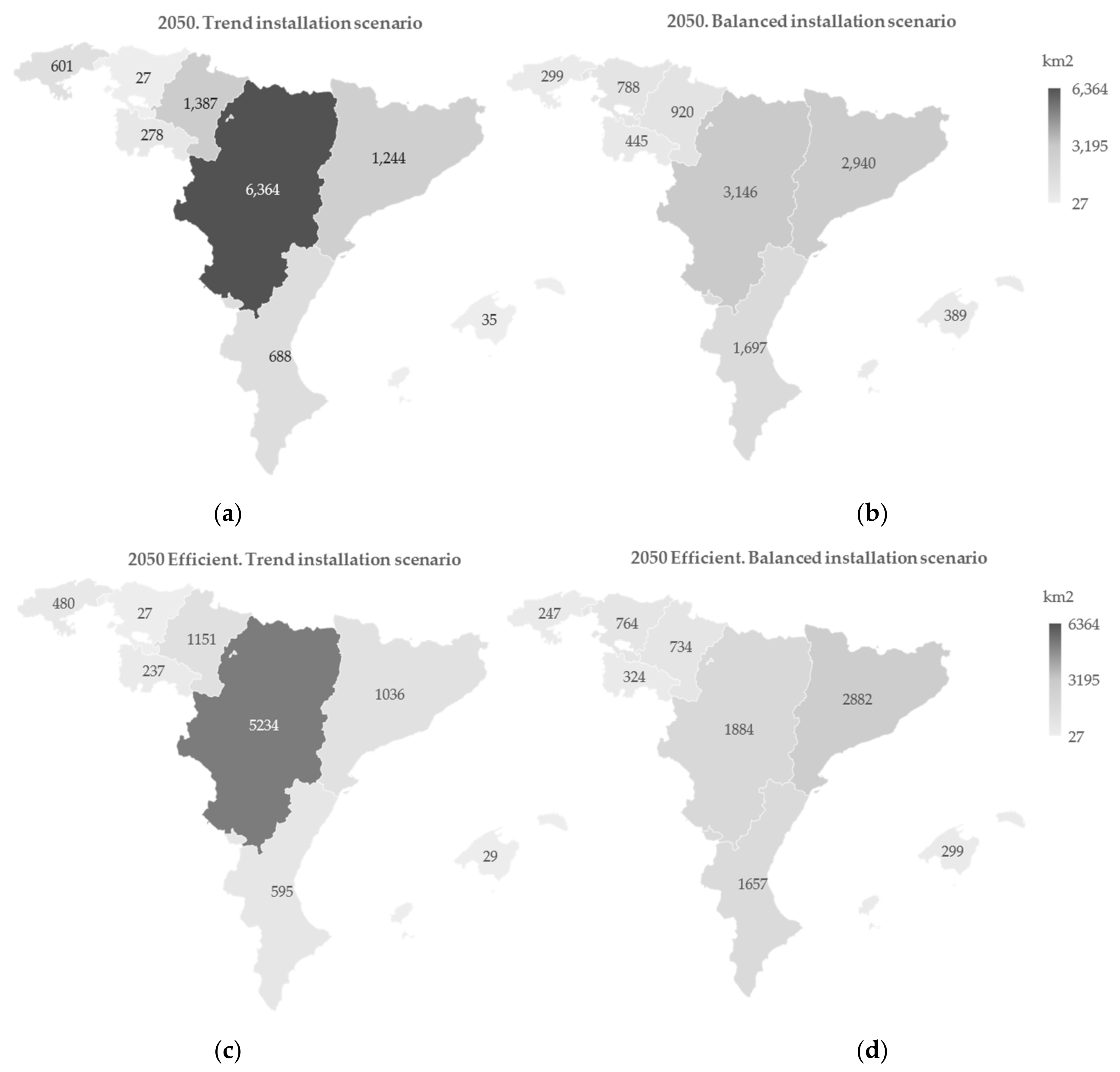
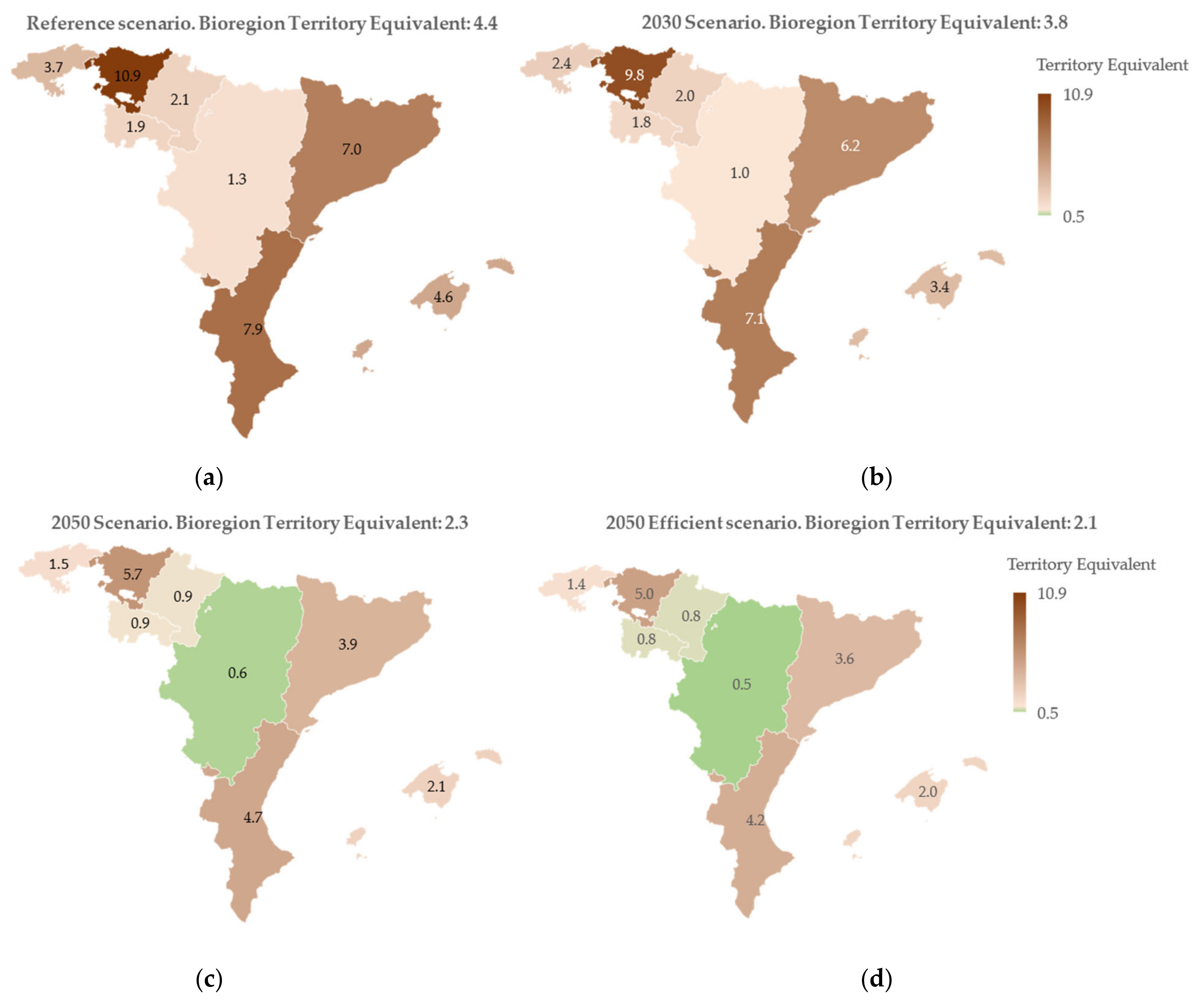
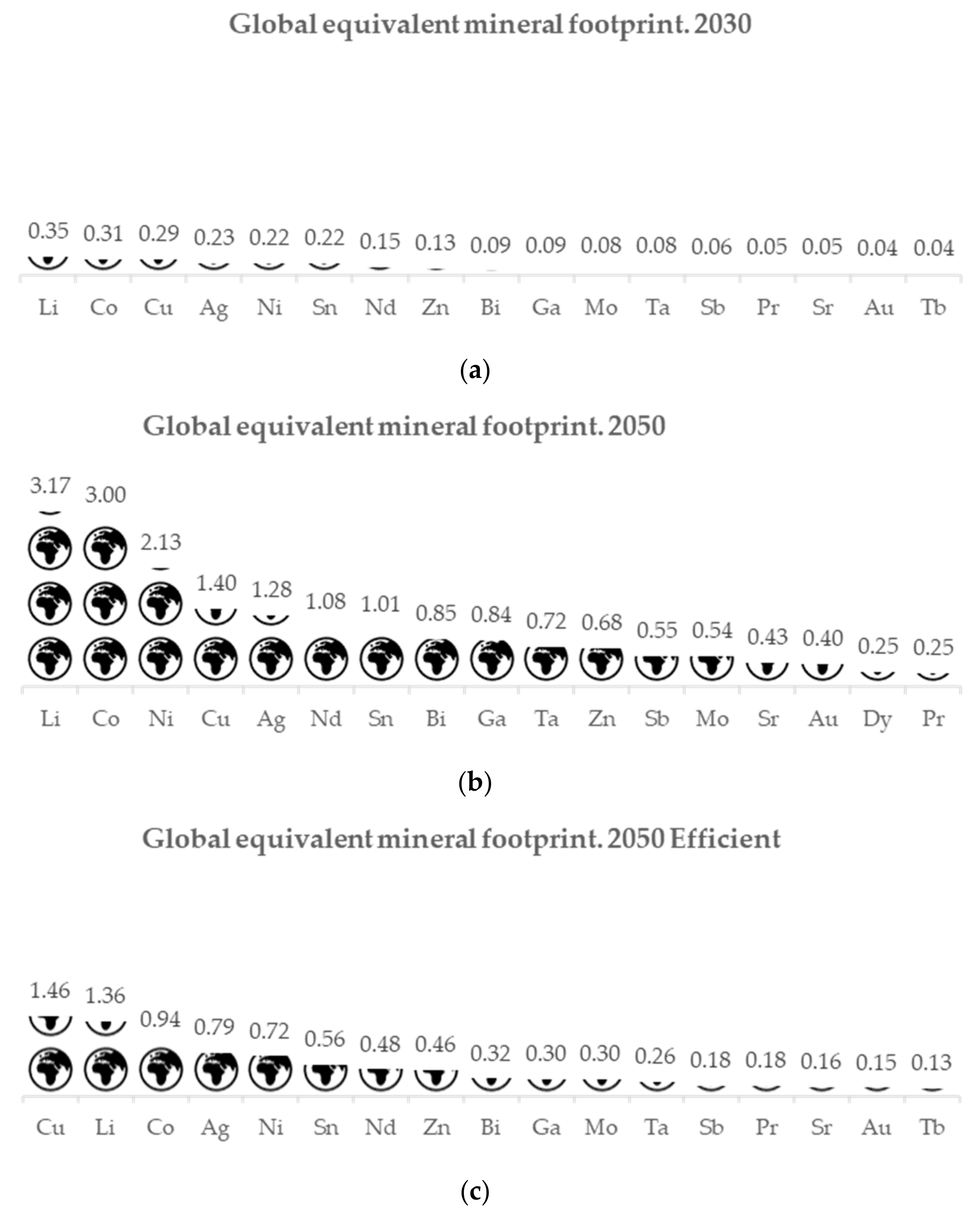
| Indicator | Aragon | Balearic Islands | Valencian Community | Cantabria | Catalonia | La Rioja | Navarre | Basque Country |
|---|---|---|---|---|---|---|---|---|
| Population density (people/km2) | 28 | 240 | 215 | 109 | 237 | 62 | 63 | 302 |
| Area (km2) | 47,720 | 4992 | 23,255 | 5321 | 32,113 | 5045 | 10,391 | 7234 |
| GDP per capita | 28,727 € | 23,206 € | 23,206 € | 24,383 € | 31,119 € | 28,200 € | 32,141 € | 34,142 € |
| Electricity demand (GWh) | 10,109 | 4942 | 25,457 | 3906 | 43,840 | 1621 | 4844 | 14,955 |
| Electricity imports (GWh) | −7997 | 1427 | 6347 | 2100 | 888 | −171 | −1767 | 8788 |
| Sectorial Transformations | Assumptions |
|---|---|
| Transport electrification | Combustion cars replacement by battery electric vehicles as this is the lowest cost solution [3,47,48]. Electrification of existing diesel railroads [49]. Maritime and air transport have not been assessed. |
| Zero-emission industry | Replacement of fossil fuel energy sources considered on the 2050 European Commission Reference Scenario for industry [50] by biofuels (mainly biogas) and hydrogen. An 80% electrolysis efficiency for hydrogen production. |
| Electrification of household and service sectors | Electrification of heating, domestic hot water, and cooking [51] as it is the highest efficiency solution [3]. Residential consumption increases linearly to population growth, choosing an income elasticity value of 0.2 between GDP and consumption increase [52]. |
| Primary sector | Energy consumption in the primary sector does not change in 2050. Consumption reduction offsets the primary sector growth thanks to efficiency [45]. On the other hand, there is a greater need for a modal shift to reduce its emissions [53]. |
| Scenario | Information Gathered | Autonomous Community or State | Reference |
|---|---|---|---|
| Reference scenario | Energy balance reports and sectorial energy demand. | Aragon | [55] |
| Balearic Islands | [56] | ||
| Catalonia | [57] | ||
| Valencian Community | [58] | ||
| Basque Country | [59,60] | ||
| Navarre | [61] | ||
| Spain | [62,63,64] | ||
| Reference scenario | Electricity mix, electricity demand, and nameplate capacity | All autonomous communities | [65,66] |
| Reference scenario | Renewable capacity trend installation | All autonomous communities | [38] |
| Reference scenario | Final energy consumption by mode of transport | All autonomous communities | [63,67] |
| Reference scenario | Vehicle fleet | All autonomous communities | [68] |
| Reference scenario | Km travelled by mode of transport and activity forecast | All autonomous communities | [50,69] |
| Reference scenario | Final energy consumption by uses in residential and service sectors | All autonomous communities | [70] |
| 2030 Scenario | Energy demands | All autonomous communities | [21] |
| 2030 Scenario | De-installation of conventional thermal plants | All autonomous communities | [21] |
| 2050 Scenario | Sectoral decarbonization | All autonomous communities | [3,53,71] |
| 2050 Scenario | 2050 zero-emission industry demands forecast | All autonomous communities | [45,50] |
| 2050 Scenario | Growth and activity forecast | All autonomous communities | [45,50,72] |
| All scenarios | Renewable technologies capacity factor | All autonomous communities | [42,66,73] |
| All scenarios | Renewable resources (biomass, wind, biogas…) | All autonomous communities | [42,74,75,76,77] |
Publisher’s Note: MDPI stays neutral with regard to jurisdictional claims in published maps and institutional affiliations. |
© 2022 by the authors. Licensee MDPI, Basel, Switzerland. This article is an open access article distributed under the terms and conditions of the Creative Commons Attribution (CC BY) license (https://creativecommons.org/licenses/by/4.0/).
Share and Cite
Felipe-Andreu, J.; Valero, A.; Valero, A. Territorial Inequalities, Ecological and Material Footprints of the Energy Transition: Case Study of the Cantabrian-Mediterranean Bioregion. Land 2022, 11, 1891. https://doi.org/10.3390/land11111891
Felipe-Andreu J, Valero A, Valero A. Territorial Inequalities, Ecological and Material Footprints of the Energy Transition: Case Study of the Cantabrian-Mediterranean Bioregion. Land. 2022; 11(11):1891. https://doi.org/10.3390/land11111891
Chicago/Turabian StyleFelipe-Andreu, Javier, Antonio Valero, and Alicia Valero. 2022. "Territorial Inequalities, Ecological and Material Footprints of the Energy Transition: Case Study of the Cantabrian-Mediterranean Bioregion" Land 11, no. 11: 1891. https://doi.org/10.3390/land11111891
APA StyleFelipe-Andreu, J., Valero, A., & Valero, A. (2022). Territorial Inequalities, Ecological and Material Footprints of the Energy Transition: Case Study of the Cantabrian-Mediterranean Bioregion. Land, 11(11), 1891. https://doi.org/10.3390/land11111891










